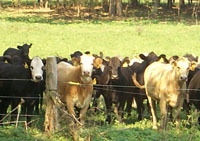2002 Livestock and Dairy Outlook Steady
2002 Livestock and Dairy Outlook Steady

Kentucky livestock producers generally have profited throughout 2001 and that should continue into the coming year according to University of Kentucky Agricultural Economist, Lee Meyer.
Speaking to an audience at the annual Kentucky Farm Bureau convention in Louisville, Meyer said meat consumption was down about three pounds per person in 2001. He expects a further decline in 2002, although it will be small.
“Since 1999, we’ve seen small declines in beef demand and all meat species,” he said. “We’ll see a continued decline over the next year in beef demand, due to a decrease in beef production and small increases in other species.”
Meyer expects increases in both pork and poultry, with a hog industry expansion of two to four percent in the Commonwealth.
“The pig crop is up about two percent,” he said. “With strong profits, expansion will continue giving us more pork in 2002, resulting in a three to four percent increase by the end of the third quarter of 2002. That also probably means a drop in prices, maybe $3 below this year on average.”
Meyer said the poultry industry will continue to see increasing profits and also will expand per capita supplies. Wholesale prices will stay steady and Meyer believes that means continued profits for the grower industry.
On the cattle side of things, Meyer pointed out that although the economy is a driving factor, demand has not been rocked as much as some think.
“The economy is critical to beef demand,” he said. “We project demand for feeder cattle to be pretty strong for next year and that will be a positive factor in terms of prices.”
Meyer said drops in the market have been on many producers minds, but not much attention has been paid to the recovery.
The base demand is still pretty strong and that gives some good indication of next year. We expect beef production to be down about 3 percent, resulting in about a $3/cwt increase in slaughter cattle for 2002, he said.
“Overall, the short term feeder market will be pretty strong. In the long run, we know the cattle cycle plays a vital role,” Meyer continued. “The cattle cycle, lack of expansion, drought problems and many other factors have kept us from adding cows to the herds, so we’re looking at a continued three to four years of profitable calf prices. The longer-run scenario looks really good if demand stays strong.”
Meyer also reported that Phase 1 programs are starting to have an impact. Producers are starting to make some changes that will help on the marketing and production cost sides of the industry.
“Overall we’re doing a lot of things right in Kentucky and that will help us take advantage of the next few years of profitable prices,” he said.
Kentucky’s dairy industry staged a surprising recovery in 2001 and saw milk prices increase.
“A combination of bad weather and low expectations kept supply down, and higher replacement heifer prices kept a lot of cows on the job when they were past their prime and that really cut into milk per cow,” said Leigh Maynard, UK agricultural economist. “It’s the first time we’ve seen milk per cow growth actually stop in a long time. Faltering supply, coupled with robust demand, really helped prices increase.”
Maynard said dairy farmers are using 2001 profits to expand herds and improve their productivity with fresh cows.
“A slow economy makes people stay home more and eat out less,” he said. “That reduces cheese and butter consumption.”
Since most futures markets reflect economy expectations, predicted 2002 price levels should allow most Kentucky dairy farmers to at least break even next year, but not earn large profits.
Maynard urged farmers to be cautious of further price drops. He said buying put options is probably the simplest and safest way to avoid income loss from falling prices, but low participation in the USDA’s Dairy Option Pilot Program suggests most Kentucky farmers remain exposed to a price risk.
“New flavored milk products should continue to be an exciting source of sales growth in 2002,” he said. “Functional dairy products offer long-term demand growth potential.”